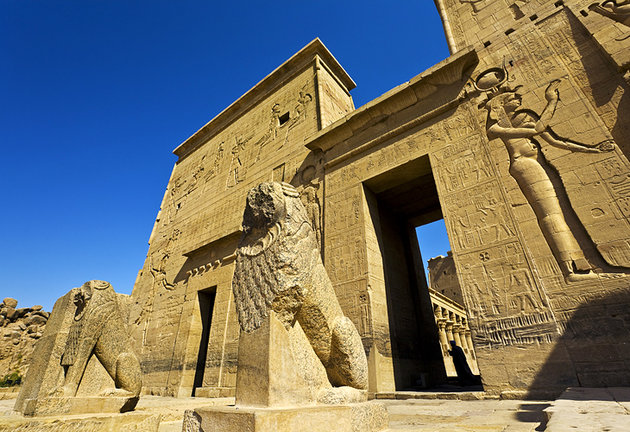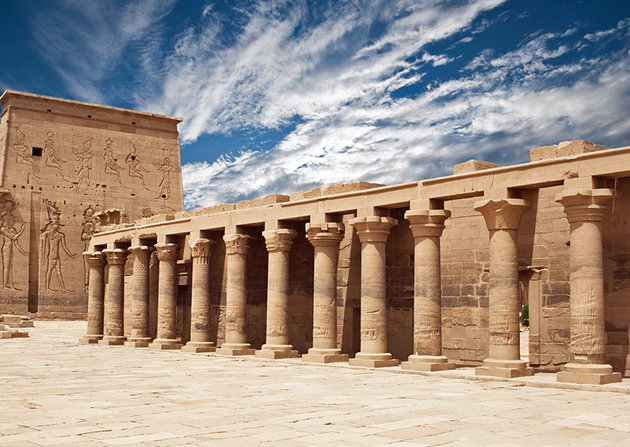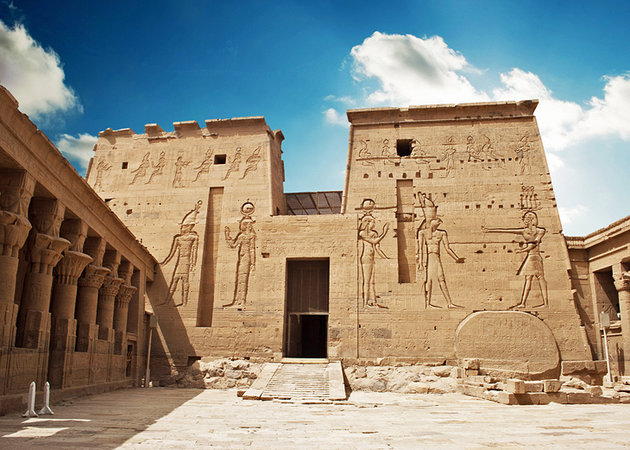
Philae Temple
One of Nubia's most important monument sites, the Temples of Philae, 12 kilometers south of Aswan, was an ancient pilgrimage center for the cult of Isis and dazzled travelers with its power for centuries. This sacred site was venerated from the Pharaonic era up to the Greek, Roman, and Byzantine periods with each ruler adding their own stamp onto the stones here. Saved from a watery grave by UNESCO's rescue project, which transferred the monuments block by block from Philae Island to Agilika Island, today, the temples continue to work their charm on all who visit.

Image: The Temple's Entranceway.

Image: The Temple's Main Courtyard.
As you pass through the central doorway look for the French inscription ("an 7 de la République") on the right, commemorating Napoleon's campaign and the pursuit of the Mamelukes by General Desaix in 1799.
Image: Entry to the Inner Temple.
The Second Pylon provides a fittingly regal entry to the inner sanctum of the temple with a magnificent doorway 32 meters wide and 12 meters high. The reliefs on the central doorway are by Euergetes II. In front of the doorway are the foundations of a small chapel. Within the central doorway (on the right, above) are some much faded early Christian paintings. Don't Miss: On the lower part of the doorway is a relief of a large figure of Neos Dionysos dedicating the slaughtered sacrificial animals to Horus and Hathor. Above are two small reliefs. On the right, the king is depicted presenting a garland to Horus and Nephthys and on the left, offering incense to Osiris, Isis, and Horus while pouring water on the altar.
Image: Entering the Inner Temple.
The eight-columned Vestibule is the first room of the inner temple area and was originally separated from the court by screens between the columns on the front. Look for the Coptic crosses and Greek inscription incised into the walls that show how the temple was transformed into a Christian place of worship during the early Byzantine age under the Coptic Bishop Theodore. Also, look above the door for the inscription commemorating the archaeological expedition sent to Philae in 1841 by Pope Gregory XVI. Don't Miss: Although the Vestibule's reliefs were left unfinished and are now ruinous, they are still highly interesting. Over the door in the south wall, the top relief shows Horus seated on a bench with Nephthys and Isis presenting the crowns of Lower and Upper Egypt. Thoth (left) and Seshat, the goddess of writing (right), inscribe the king's name on a palm branch, while behind Thoth is the air god Shu, holding a sail. The below reliefs depict the tomb of Osiris at Abaton, with the body of Osiris borne by a crocodile. To the left of the door are unfinished reliefs showing the king making grants of land, while above are three lines in Meroitic cursive script. On the right hand wall (second top row) is a famous relief depicting the source of the Nile: the god of the Nile, with a snake entwined around his body, pours water from two jars under a rocky crag on which are perched a vulture and a falcon. To the right of this is the soul of Osiris in the form of a bird within the sacred grove, worshiped by Hathor (left) and by Isis, Nephthys, Horus, and Amun (right).